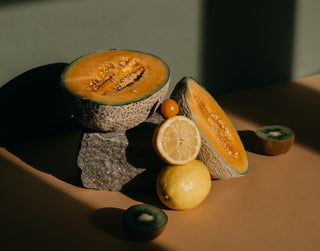(Psst…none of this is medical advice–just a word to the wise.)
The notion that vitamin C is good for your skin isn’t new.
This potent antioxidant renews and protects skin cells against the damaging effects of oxidative stress.
We’re willing to bet you already knew that.
It seems like the skincare industry pumps out a new “brightening” or “anti-wrinkle” vitamin C serum every other day.
But what a lot of these products miss is the type of vitamin C they use.
Just like there are multiple forms of retinol, with varying degrees of bioavailability, there are several different types of vitamin C– some better than others.
Let’s review what sets tetrahexyldecyl ascorbate apart from the rest and why your skin will absolutely love it.
(Try saying that ten times fast ^^)
The problem with vitamin C in skincare.
Nearly all forms of vitamin C are water-soluble. (1)
This makes them highly unstable and much more prone to oxidizing when exposed to light, air, or even your skin.
The most unstable of them all is L-ascorbic acid.
But this doesn’t mean L-ascorbic acid is bad for you– quite the opposite, actually.
It’s the purest form found in food. (2)
Think orange juice, kiwi, camu camu, and raw milk.
When bound to its whole-food source, L-ascorbic acid is incredibly good for you and supports several metabolic processes in the body.
We need it to build collagen, neutralize free radicals, make adrenal hormones, and stimulate immune cells in the blood. (3) It’s pretty important.
That being said, it just doesn’t play well with our skin.
Its acidic pH (<3) and instability make it highly irritating for sensitive skin.
And since it’s not fat-soluble, it can’t easily penetrate the deeper layers of the skin (where the real healing work takes place).
What is tetrahexyldecyl ascorbate? Why is it so much better for your skin?
It may be difficult to pronounce, but this more stable form of vitamin C is much easier for your skin to absorb.
In fact, it penetrates the skin three times more effectively than pure vitamin C. (4)
This is because like attracts like.
Our skin is essentially a layered network of protein fibers and fat cells, so it drinks up this fat-soluble form of vitamin C, like lemonade on a hot day.
Since it absorbs more efficiently and has a less acidic pH (<5), it's MUCH gentler on the skin than pure vitamin C.
How tetrahexyldecyl ascorbate protects your cells. (benefits you can’t see)
Just like pure vitamin C, tetrahexyldecyl ascorbate is a powerful antioxidant that prevents oxidation in your cells.
But what exactly is “oxidation?”
It’s essentially the aftermath of free radical instability.
The reason free radicals are so damaging to your cells is because they contain one or more unpaired electrons making them wildly unstable. They roam around, seeking to steal electrons away from other molecules in the system, weakening lipids, proteins, and DNA. (5)
As more molecules become compromised, more cellular damage takes place. This can look like aging skin, fatigue, gray hair, joint pain, and increased susceptibility to disease.
And this is where tetrahexyldecyl ascorbate comes in handy.
It acts as a generous electron donor to satisfy these ravenous free radicals so they stop damaging your cells.
The more antioxidants you have in your body, the more electrons you have to give, and the longer your cells will stay healthy. Simple as that.
What tetrahexyldecyl ascorbate does for your skin. (benefits you can see)
Tetrahexyldecyl ascorbate is so beneficial for your skin because less oxidation means more resilience.
And resilient skin is damage-proof. (Hint: this is one of the many reasons we put it in Pre-Sun)
Visible benefits of using tetrahexyldecyl ascorbate on the skin:
- encourages wound repair for more balanced sun recovery and less noticeable scarring.
- stimulates collagen production to strengthen connective tissues for more elasticity.
- provides photoprotection to minimize discoloration caused by excessive sun exposure.
- evens out pigmentation on the skin for a clearer, more even tone.
- promotes healthy cell regeneration for a smoother texture.
- reduces protein fiber breakdown to soften fine lines and wrinkles.
While this form of vitamin C is great on its own, it’s even better when combined with vitamin E.
Together, they provide four times the protection against free radicals.
Fatskn Pre-Sun is so effective at utilizing the sun and preventing oxidative stress because it blends these two essential vitamins with another electron donor called methylene blue.
This team of antioxidants and saturated fats work together to give you skin that's as radiant as it is resilient.
.
.
.
As always, while we hope to be a no-nonsense resource, we encourage you to do your own research to find the healthiest options for you and your family.
You can check out our collection of good-for-you, tallow skincare products by clicking the link below. We hope to see you there!
.
.
.
REFERENCES:
- Better Health. “Food Processing and Nutrition.” Vic.gov.au, 2012, www.betterhealth.vic.gov.au/health/healthyliving/food-processing-and-nutrition.
- https://www.facebook.com/verywell. “Acne Medications That Make You More Sensitive to the Sun.” Verywell Health, 28 Jan. 2022, www.verywellhealth.com/which-acne-medications-cause-sun-sensitivity-15652.
- Lobo V, Patil A, Phatak A, Chandra N. Free radicals, antioxidants and functional foods: Impact on human health. Pharmacogn Rev. 2010 Jul;4(8):118-26. doi: 10.4103/0973-7847.70902. PMID: 22228951; PMCID: PMC3249911. https://www.ncbi.nlm.nih.gov/pmc/articles/PMC3249911/
- Stamford, Nicholas P J. “Stability, Transdermal Penetration, and Cutaneous Effects of Ascorbic Acid and Its Derivatives.” Journal of Cosmetic Dermatology, vol. 11, no. 4, 23 Nov. 2012, pp. 310–317, https://doi.org/10.1111/jocd.12006.
- Lobo V, Patil A, Phatak A, Chandra N. Free radicals, antioxidants and functional foods: Impact on human health. Pharmacogn Rev. 2010 Jul;4(8):118-26. doi: 10.4103/0973-7847.70902. PMID: 22228951; PMCID: PMC3249911. https://www.ncbi.nlm.nih.gov/pmc/articles/PMC3249911/

